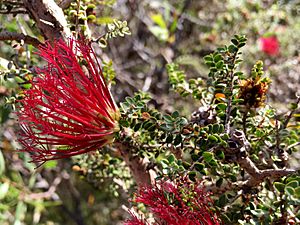Elegant beaufortia facts for kids
Quick facts for kids Elegant beaufortia |
|
|---|---|
 |
|
| Beaufortia elegans growing in Stirling Range National Park | |
| Scientific classification | |
| Genus: |
Beaufortia (plant)
|
| Species: |
elegans
|
| Subspecies | |
|
Beaufortia elegans var. minor Benth., 1867 |
|
| Synonyms | |
|
Melaleuca scitula Craven & R.D.Edwards |
|
The Elegant Beaufortia (scientific name: Beaufortia elegans) is a beautiful plant. It belongs to the myrtle family, called Myrtaceae. This plant grows only in the southwest part of Western Australia. This means it is endemic to that area.
It is a shrub that stands upright and spreads out. It has many leaves that are close together and curved. Its flowers usually grow in heads and are reddish-purple. Sometimes, you might see other colors too.
Contents
What the Elegant Beaufortia Looks Like
The Elegant Beaufortia is a shrub that usually grows upright. It can reach a height of about 2.5 meters (8 feet). Its leaves are small, about 2 to 5 millimeters long. They are arranged in pairs opposite each other. The leaves are also curved, dish-shaped, and grow very close together. They do not have a stalk.
Flowers and Fruits
The flowers of this plant are often red or a dark purplish-red. But sometimes, you can find white flowers or other colors. They grow in round clusters, about 20 millimeters (0.8 inches) wide. These flower clusters are found at the ends of branches. The branches keep growing even after the flowers bloom.
Each flower has 5 sepals, which are like small leaves protecting the bud. It also has 5 petals, which are the colorful parts. There are 5 groups of stamens, which are the parts that make pollen. Each group has 4 to 7 stamens joined together. The joined part is about 3 to 4 millimeters long. The free parts of the stamens are about 4 to 6 millimeters long.
The Elegant Beaufortia usually flowers from June to January. The best time to see them is from October to December. After flowering, the plant produces fruits. These fruits are woody, round capsules. They are about 8 to 10 millimeters (0.3 to 0.4 inches) wide.
How it Got its Name
The scientific name Beaufortia elegans was first officially described in 1843. This was done by a scientist named Johannes Conrad Schauer. He wrote about it in a book called Dissertatio phytographica de Regelia, Beaufortia et Calothamno.
The second part of its name, elegans, is a Latin word. It means "fine," "choice," or "tasteful." This name perfectly describes the plant's beautiful appearance.
Where the Elegant Beaufortia Grows
The Elegant Beaufortia mostly grows in Western Australia. You can find it in the areas between Perth and Geraldton. These areas include the Avon Wheatbelt, Geraldton Sandplains, Jarrah Forest, and Swan Coastal Plain.
It usually grows in sandy soil. It is often found in a type of plant community called kwongan vegetation. This plant community often grows over a hard, reddish soil layer called laterite. It also likes areas that get wet during the winter.
Protecting the Elegant Beaufortia
The Western Australian Government's Department of Parks and Wildlife checks on plants. They have classified the Elegant Beaufortia as "not threatened." This means that there are enough of these plants in the wild. So, they are not currently at risk of disappearing.

